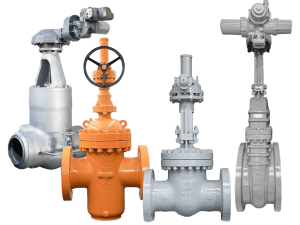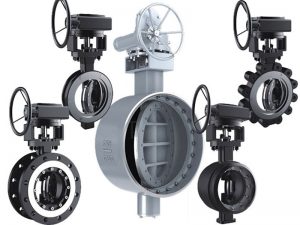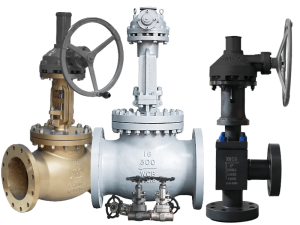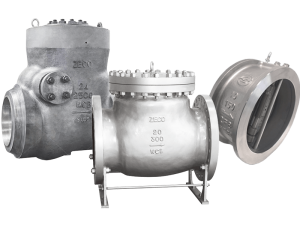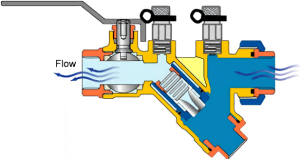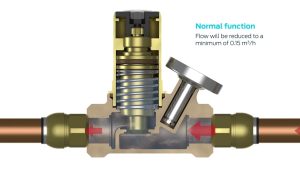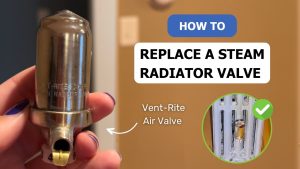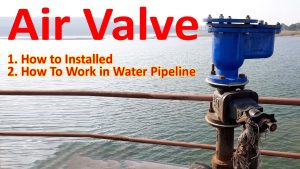Las válvulas industriales son cruciales para controlar el caudal de líquidos, gases, lodos o sólidos fluidizados en una amplia gama de aplicaciones. Sin embargo, con tantas opciones entre las que elegir, seleccionar la válvula adecuada puede ser todo un reto.
Dos de los tipos más comunes de válvulas industriales son las válvulas de compuerta y las válvulas de bola. A primera vista, ambas válvulas parecen muy similares: sirven para arrancar, parar y regular el caudal. Pero hay algunas diferencias importantes en cómo están diseñadas, sus ventajas y sus mejores casos de uso.
¿Debe utilizar una válvula de compuerta o de bola? Aquí tiene una guía completa que le ayudará a decidir.

Funcionamiento de las válvulas de compuerta y de bola
Empecemos por echar un rápido vistazo bajo el capó para entender cómo funcionan realmente las válvulas de compuerta y las válvulas de bola.
Válvulas de compuerta
Como su nombre indica, válvulas de compuerta utilizan una "compuerta" plana para controlar el caudal. Esta compuerta se mueve perpendicularmente a la trayectoria del caudal para iniciarlo, detenerlo o estrangularlo.
Estos son los componentes clave de una válvula de compuerta:
- Cuerpo: Alberga la puerta y otros componentes
- Capó: Cubre el vástago y la empaquetadura del prensaestopas
- Puerta: La placa que bloquea o permite el flujo
- Vástago: Conecta la puerta al volante
- Asiento: Superficie de sellado de la compuerta cuando la válvula está cerrada
- Embalaje: Evita fugas alrededor del vástago
Para abrir la válvula, gire el volante para levantar la compuerta del asiento. Cuando está completamente abierta, la compuerta ya no obstruye el paso del caudal a través del cuerpo de la válvula.
Para cerrarla, hay que bajar la compuerta hasta el asiento para crear un cierre hermético y detener el flujo. Si es necesario, la válvula también puede abrirse parcialmente para estrangular el caudal.
Válvulas de bola
En un válvula de bolaEn lugar de una compuerta, se utiliza una bola giratoria con un orificio para controlar el caudal. Al girar la bola 90 grados, el orificio se alinea con el cuerpo de la válvula para permitir el flujo. Al girarla 90 grados, la bola se alinea con el cuerpo de la válvula para permitir el paso del caudal.
Las válvulas de bola constan de:
- Cuerpo: Alberga la bola y el vástago
- Pelota: Componente giratorio con orificio
- Asientos: Superficie de sellado de la bola cuando la válvula está cerrada
- Vástago: Conecta la bola al mango para su funcionamiento
- Embalaje: Evita fugas entre el cuerpo y el vástago
Válvula de bola vs Válvula de compuerta: Principales diferencias
Ahora que ya sabe lo que hay dentro de una válvula de compuerta y una válvula de bola, vamos a comentar algunas de las principales diferencias al comparar los dos tipos de válvulas.
Operación
Una de las mayores diferencias radica en la forma de manejarlos.
Válvulas de bola sólo necesitan un giro de 90 grados para abrir o cerrar completamente la válvula. Esta operación de 1/4 de vuelta las hace muy rápidas de manejar.
Válvulas de compuertaPor el contrario, para subir o bajar la compuerta hay que dar varias vueltas de 360 grados al volante. Por lo tanto, su funcionamiento requiere más tiempo y esfuerzo que el de las válvulas de bola.
Capacidad de sellado
Ambas válvulas ofrecen un excelente cierre cuando están cerradas. Pero válvulas de bola tienden a formar juntas ligeramente mejores, ya que hay menos huecos para fugas en el diseño.
Esto los hace muy adecuados para aplicaciones que requieren una fuga mínima de fluidos cuando están inactivos durante largos periodos. Por ejemplo, tuberías enterradas que manipulan líquidos volátiles como petróleo crudo o gases.
Las válvulas de compuerta siguen sellando muy bien, pero pueden permitir pequeñas fugas si se mantienen cerradas durante meses.
Presiones nominales
En la mayoría de los casos, encontrará que válvulas de compuerta tienen presiones nominales más altas que las válvulas de bola del mismo tamaño y material.
Las válvulas de compuerta suelen estar clasificadas para presiones como 200 psi, 300 psi o incluso 600 psi para los modelos de alta presión.
Las válvulas de bola suelen alcanzar una presión máxima de 800 psi en los modelos estándar. Usted puede conseguir válvulas de bola especiales que manejan presiones de hasta 1500 psi, pero estos cuestan más.
Por lo tanto, si necesita una válvula que pueda soportar presiones realmente altas, una válvula de compuerta suele ser la mejor elección.
Capacidad de control de flujo
Ambos tipos de válvula permiten detener completamente el caudal. Pero, ¿qué pasa con la regulación del caudal?
Válvulas de bola sobresalen en el arranque rápido y la detención completa del flujo. También se pueden utilizar para estrangular el flujo, pero solo hasta cierto punto.
Lo mejor para las válvulas de bola es que estén completamente abiertas o cerradas. Las aperturas parciales pueden dañar la bola o los asientos con el tiempo en aplicaciones de estrangulación.
Válvulas de compuertapor el contrario, son muy adecuadas para regular con precisión el caudal. Puede controlar con precisión el caudal levantando ligeramente la compuerta del asiento.
Las válvulas de compuerta también suelen tener menos problemas de erosión que las válvulas de bola cuando se utilizan para regular el caudal.
Costo
Si el coste es un factor importante en su proyecto, válvulas de compuerta suelen ser la opción más económica.
Las válvulas de compuerta sencillas son económicas, y oscilan entre $50 y $250 según el tamaño y el material. El precio sigue siendo relativamente bajo incluso para los modelos especiales de alta presión o criogénicos.
Válvulas de bola casi siempre tienen un precio más elevado. Por ejemplo, una válvula de bola estándar de 2" puede costar alrededor de $100. Si se trata de una versión de alta presión fabricada en acero inoxidable o aleación, el precio se eleva a $250 o más.
Por tanto, si su aplicación no requiere otras capacidades exclusivas de las válvulas de bola, las válvulas de compuerta ayudan a mantener los presupuestos de las válvulas bajo control.
Aplicaciones más adecuadas para cada válvula
Ahora que conoce las principales diferencias entre estos dos tipos habituales de válvulas, vamos a hablar de las aplicaciones para las que son más adecuadas.
Cuándo utilizar una válvula de compuerta
He aquí algunos ejemplos de aplicaciones en las que una válvula de compuerta tiene más sentido:
- Redes de agua: Las válvulas de compuerta son muy comunes en los sistemas municipales de distribución de agua para iniciar y detener flujos. Su funcionamiento más lento evita problemas de golpes de ariete.
- Sistemas de vapor: Se utiliza para aislar líneas de vapor, ya que el cuerpo de la válvula de compuerta permanece más frío en comparación con otros diseños.
- Líneas de aguas residuales: La materia orgánica y los sólidos no dañarán la compuerta tan fácilmente como una válvula de bola.
- Aplicaciones de alta presión: Las válvulas de compuerta tienen una excelente estanqueidad incluso a altas presiones, en torno a 1500+ psi.
- Servicios criogénicos: Las válvulas de compuerta especiales "criogénicas" permanecen operativas incluso a temperaturas de fluido extremadamente bajas.
- Tuberías de gran tamaño: Las válvulas de compuerta están disponibles en diámetros muy grandes para adaptarse a tuberías enormes.
Básicamente, querrá seleccionar una válvula de compuerta cuando manipule agua, vapor u otros fluidos a altas presiones, en tuberías de gran diámetro o en condiciones criogénicas.
Cuándo utilizar una válvula de bola
He aquí algunos ejemplos en los que una válvula de bola suele ser la mejor opción:
- Sistemas de gas combustible: Las válvulas de bola eliminan prácticamente los problemas de fugas cuando se utilizan en tuberías de gas natural y petróleo líquido.
- Líneas de procesamiento químico: La superficie de la bola resiste la corrosión de los productos químicos. Las válvulas de bola también evitan los problemas de acumulación de contaminación.
- Sistemas HVAC: El funcionamiento rápido de 1⁄4 vueltas permite iniciar y detener rápidamente los flujos según sea necesario en los sistemas de calefacción/refrigeración.
- Circuitos de aire comprimido: Las válvulas de bola mantienen la estanqueidad incluso con ciclos frecuentes en líneas de aire comprimido a alta presión.
- Aplicaciones de potencia hidráulica: La baja caída de presión de las válvulas de bola es importante para la eficiencia en los sistemas de transferencia de potencia de fluidos.
En resumen, le convendrá utilizar válvulas de bola para arrancar, parar o cambiar de dirección rápidamente gases, productos químicos peligrosos y líquidos con frecuencias de ciclo elevadas.
Preguntas frecuentes
A continuación encontrará respuestas a algunas preguntas frecuentes sobre las válvulas de bola y las válvulas de compuerta:
¿Son mejores las válvulas de bola que las de compuerta?
No existe una opción definitivamente "mejor". Las válvulas de bola son preferibles a las de compuerta en algunas aplicaciones por su funcionamiento más rápido, menor riesgo de contaminación o mejor estanqueidad.
Pero las válvulas de compuerta tienen ventajas como mayores presiones nominales, capacidad de estrangulación y menor coste que las convierten en una opción superior en otras aplicaciones.
Debe comparar las capacidades de cada válvula con los requisitos de su aplicación para decidir cuál es la más adecuada.
¿Se puede utilizar una válvula de compuerta para sustituir a una válvula de bola?
En algunas situaciones es posible sustituir una válvula de bola por una de compuerta. Por ejemplo, en líneas de gas o líquido a baja presión en las que la velocidad de ciclo no es crítica.
Sin embargo, puede experimentar problemas de caudal si el sistema de tuberías se diseñó para una válvula de bola. Lo mejor es consultar a un ingeniero para garantizar una intercambiabilidad perfecta antes de intentar intercambiar tipos de válvulas.
¿Cuál es la diferencia entre una válvula de compuerta y una válvula de bola?
Las principales diferencias son que las válvulas de compuerta utilizan un sistema de compuerta y tornillo para controlar el caudal, mientras que las válvulas de bola utilizan una bola giratoria con un orificio. Las válvulas de compuerta requieren varios giros para funcionar, frente a la rápida acción de 1⁄4 giro de las válvulas de bola.
Las válvulas de compuerta también soportan presiones más altas y permiten controlar mejor el caudal de estrangulación. Las válvulas de bola suelen formar juntas más estancas y tienen menos probabilidades de fugas con el tiempo.
¿Por qué son mejores las válvulas de bola que las de compuerta?
Las válvulas de bola destacan en aplicaciones que requieren un funcionamiento rápido y frecuente de apertura y cierre gracias a su diseño con giro de 90 grados. Permiten el flujo en ambas direcciones y presentan un bajo riesgo de contaminación. Además, las válvulas de bola suelen mantener un cierre hermético durante muchos ciclos.
Estas ventajas las hacen preferibles para gasoductos, líneas químicas, hidráulicas y otros sistemas de flujo cíclico o bidireccional.
¿Por qué se utilizan válvulas de compuerta en lugar de válvulas de bola?
Las válvulas de compuerta tienen mayores presiones nominales y una sofisticada capacidad de control de estrangulamiento en comparación con las válvulas de bola. Esto las hace muy adecuadas para flujos de vapor, agua y otros líquidos o gases que:
- Necesidad de manejar presiones muy altas de hasta 2000+ psi
- Requieren una regulación precisa del caudal
- Disponen de tuberías de gran diámetro
- Riesgo de contaminación del orificio de una válvula de bola
Conclusión
Decidir entre una válvula de compuerta o una válvula de bola depende en gran medida de las especificaciones y condiciones de funcionamiento de su aplicación concreta.
Las válvulas de compuerta son la opción económica para manejar fluidos a alta presión, temperaturas criogénicas o materiales cáusticos. Su capacidad de estrangulación también permite un control más suave del caudal.
Las válvulas de bola son excelentes cuando hay que arrancar, parar o cambiar el sentido del flujo con frecuencia. Sus juntas estancas evitan fugas incluso tras largos periodos de inactividad.
Ahora que conoce los pros y los contras de las válvulas de bola y las válvulas de compuerta, puede tomar una decisión informada sobre cuál es la mejor para sus necesidades específicas. Utilice los ejemplos de aplicación y las preguntas frecuentes de esta guía para elegir el tipo de válvula adecuado para cualquier sistema de tuberías industriales.


